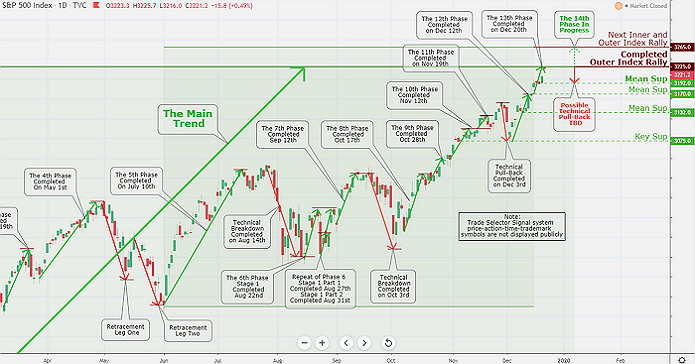Market Commentary & Analysis December 21, 2019

The S&P 500 market entered another milestone, bettering the 3200 price level in a 1.7% rise this week with Friday's high of $3,225.7 - Known to us since July, 2019.
The DJI Average posted +1.1% gain and heavy technology loaded Nasdaq Composite index increased +2.2% while rallied further into new record territory. The small-cap Russell 2000 index kept in step with the Nasdaq Composite with a solid print of 2.1% weekly addition.

Click the Image to Enlarge
Technical Analysis and Outlook
Currently, the index completed the 13th Phase (Act surprised); however, likely weed out weak long (Pullback) might be possible initially to Mean Sup $3,192 - TBD by Trade Selector TARC symbol (Not shown).
We will monitor the index very carefully for the next few days, while the Phase 14th is in progress. On the downside, there are additional supports: Mean Sup $3,170, Mean Sup $3,132, and Key Sup $3,075.
And the rest of the story
There was no positive catalyst propelling the market action this week, although there wasn't anything impeding the market's record movement. So, why did the Fed initiated QE4 while the equities are at an all-time high?.
It’s because the Fed is trying to keep the rigged financial system alive. That is what all about, and we are not shocked because we understand that the global financial system is thoroughly sick.
We also know that there are tremendous burdens not just with British, Italian, French, Commerzbank, and Deutsche Bank banks, but the very same thing is befalling all American banks.
The Goldman Sachs of this world, the JP Morgan, Citibank, Morgan Stanley - the very same banking institutions almost went under in 2007/8 financial bust.
Market action
Market reaction to better-than-expected last month numbers for industrial production, building permits, housing starts, personal income, and personal spending boosted the market's positive economic standpoint. Home builder confidence even grew to its highest level ever as of 1999 - according to the NAHB (National Association of Home Builders) Housing Index.
Virtually all eleven S&P 500 sectors closed higher, with the real estate sector posting +2.7%, utilities sector print +2.7%, communication services sector showing +2.5%gain, energy sector increased +2.5%, and health care sector went up +2.3%. The industrials sector with a gain of only +0.3% underperformed amid losses posted by Boeing and FedEx.
FedEx announced disappointing earnings results and direction, while aircraft maker Boeing told it would suspend 737 MAX plane production commencing next year in January.
In the district of corruption (Washington), the House of Representatives declared passage of the United States–Mexico–Canada Agreement (USMCA) agreement and voted to impeach duly elected by the people President Trump.
However, neither had much impact on the broader market behavior, as both outcomes were highly expected, while the consensus outlook is that the Republican-controlled Senate will secure Trump's presidency.
Elsewhere
This week Mergers and acquisitions (M&A) activity featured the most significant transaction as DuPont agreeing to merge its Nutrition & Biosciences segment unit with International Flavors & Fragrances, Inc. in a combined $45.4 billion deal.
United States Treasuries faded amid the risk-on trading sentiment, pushing yields higher in the yield curve-steepening trading. The two-year yield rose three basis points to close at 1.63%, and the Ten-year yield improved ten basis points to finish at 1.92%.
The Dollar Index (DXY) surged 0.6% to post a 97.70 print. While West Texas Intermediate (WTI) crude oil improved 0.5%, or $0.27, to close $60.41/bbl for the week.